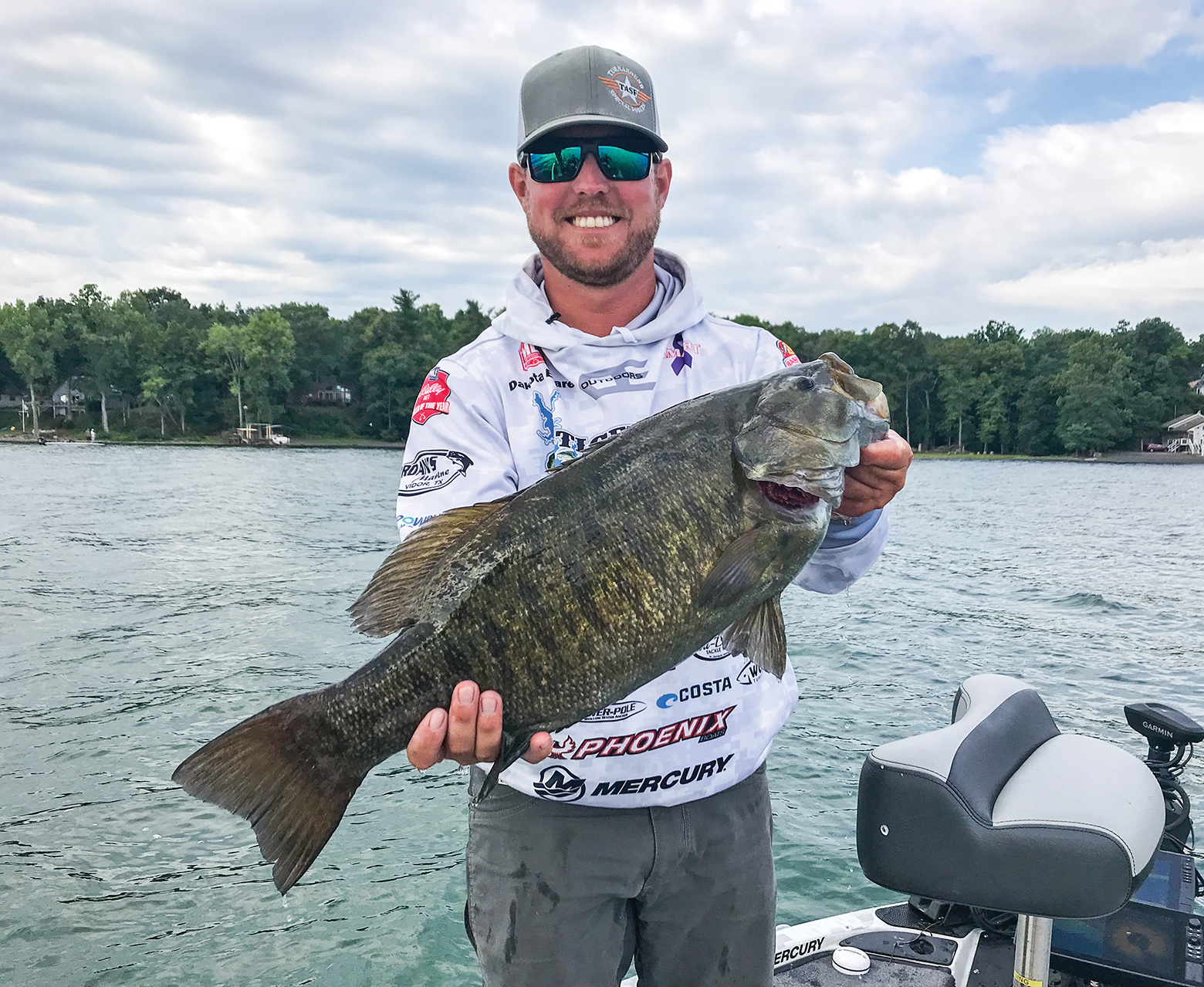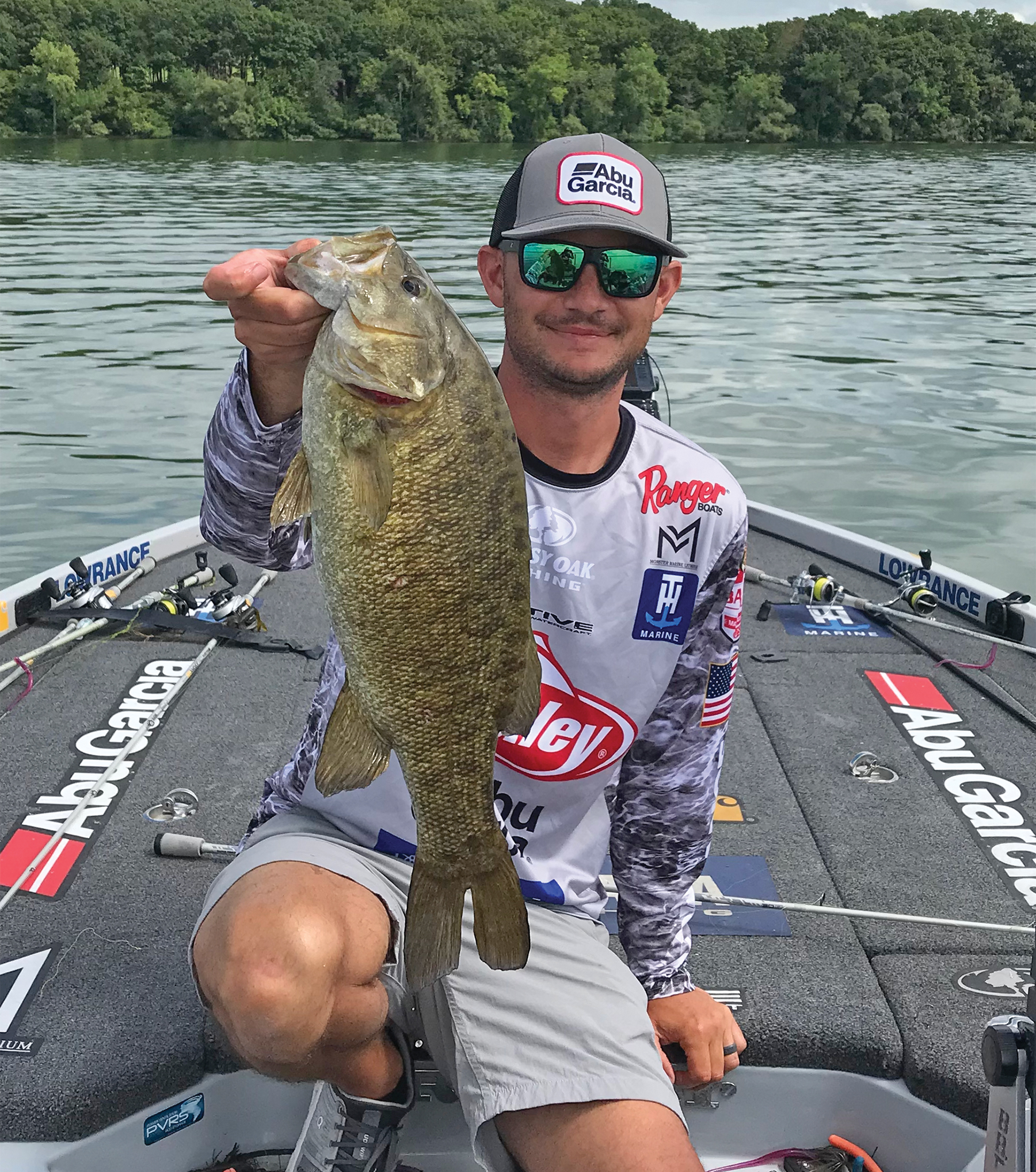Taking a deep dive into Cayuga Lake smallmouth
Early June Bass Pro Tour event benefits from catch, weigh, immediate-release format

The early June return of the Bass Pro Tour to Cayuga Lake, New York – for Favorite Fishing Stage Five Presented by ATG by Wrangler – refocuses the world’s attention on the outstanding smallmouth fishery that thrives in this gem of New York’s Finger Lakes region. It also reminds us that there are probably a lot of fishing fans out there who might enjoy a deeper dive into Cayuga.
Cayuga Lake at a glance
- Cayuga Lake is the second-largest of the 11 Finger Lakes in upstate New York, spanning 42,956 surface acres, reaching a maximum depth of 435 feet and stretching north/south for a length of 38 miles.
- The lake has a two-tier sportfish population, supporting both cold and warm water species. The sportfish opportunities include rainbow trout, Atlantic salmon, brown trout, lake trout, lake sturgeon, largemouth bass, smallmouth bass, northern pike, bluegill, black crappie, yellow perch and channel catfish.
- Forage fish are primarily open-water species such as alewives, rainbow smelt, gizzard shad and various shiner minnow species. Larger forage species including yellow perch, pumpkinseed and bluegill sunfish also exist and are abundant at times. More recently, exotic round goby have established a thriving population, supported by their ability to consume zebra mussels.
- The upper end of Cayuga is shallower, with dense submerged vegetation that include milfoils, curly leaf pondweed, coontail and hydrilla. This diverse environment produced the New York state record 8-pound, 6-ounce bass in 2022 and is the primary reason the Bass Pro Tour events held here are so prolific.

What SCORETRACKER® data tells us
The June Cayuga event is one of three fisheries on the 2023 Bass Pro Tour schedule where we can compare data for the “every fish counts” format to the best-five-fish format. In 2022, Bass Pro Tour Stage Six on Cayuga used a 2-pound variable minimum weight and turned out to be an extraordinary showcase of the fishery. In total, 2,532 bass were recorded into SCORETRACKER® – 2,209 largemouth and 323 smallmouth. Dustin Connell won the event with a Championship Round total of 25 smallmouth for 96 pounds, 12 ounces. Dakota Ebare had Berkley Big Bass for the event with a Bass Pro Tour-record 7-10 smallmouth.
When we look into the 2022 data and start thinking about how things might play in five-fish tournaments on Cayuga, we first see a big difference in the average weight of smallmouth versus largemouth. Using our SCORETRACKER® data, we calculated the average smallmouth weight during 2022 to be 3 pounds, 11 ½ ounces while the average largemouth was 3-2. That’s a huge difference when we only count five fish this year. It will result in a 2 ½-pound difference between an average bag of smallmouth versus largemouth, which will likely be relevant around the cut line.
Percentage of fish caught by species in 2022
- 12.8% Smallmouth
- 87.2% Largemouth
The most notable change for five-fish events held on Cayuga instead of the every-fish-counts format is the species that will likely determine a winner. In the 2022 Bass Pro Tour event here, 79 of the 106 bass over 5 pounds were largemouth, which means that anglers looking to win will likely need some green fish in their daily five-fish limits.
When we rerun the numbers from 2022’s Knockout and Championship rounds using the best-five-fish scoring structure, we see a rare occasion where a different field and eventual winner would have emerged.
- Instead of being eliminated in 19th place with 11 fish for 46-12, Anthony Gagliardi would have had an impressive five-fish limit of 25-12 to lead the Knockout Round.
- The remaining top five for the Knockout Round would have been Zack Birge (25-0), Josh Bertrand (24-2), Ebare (22-2), and Connell (22-2) – Bertrand weighed only largemouth, and Gagliardi only smallmouth.
- On the final day, Birge would’ve had 21-14, Connell would’ve had 25-8 and Ebare a whopping 27-4 (with his 7-10 smallmouth being the difference-maker).
Percentage of fish 5 pounds or better caught by species in 2022
- 25.5% Smallmouth
- 74.5% Largemouth
New York C&R season
The format isn’t the only big change that makes Stage Five special this year. New York has a statewide black bass regulation that allows for the daily harvest of five fish above 12 inches from June 15 through Nov. 30, and it’s strictly catch and release with artificial lures only Dec. 1 through June 14. “Harvest” for almost all states is considered to occur at the time a fish enters into a livewell, which means all traditional weigh-in tournament anglers technically harvest up to five fish for their weigh-in. This restricts the tournament season on Cayuga to June 15 through Nov. 30, or by a special permit from the New York Department of Environmental Conservation (NYDEC).
Bass Pro Tour anglers hit the water for official practice on June 4 and tournament days are June 6-11, which is obviously during the catch-and-release season. The BPT format naturally avoids the harvest aspect of the regulation since no fish will ever technically be harvested. For the MLF Fisheries Management Division in Partnership with Berkley Labs, this is an opportunity to showcase the science behind both the regulation and allowing a catch, weigh, immediate-release tournament to take place during the state’s catch-and-release season.
Studying the key influencers
The primary reason fisheries managers limit harvest seasonally (or in certain areas) is to protect fish while they’re actively spawning. The impact of angling on spawning activity, nest and fry guarding, and nest abandonment is a fairly-well researched area of fisheries management.
Goby predation
For Cayuga Lake, round gobies now represent the most likely nest predator. A study published in 2011 titled “Round Goby Predation on Smallmouth Bass Offspring (sic.) in Nest During Simulated Catch and Release Angling” by Geoffrey B. Steinhart, Elizabeth A. Marschall, and Roy A. Stein addresses the potential for goby nest predation. In this study, smallmouth bass nests located around Bass Island in Lake Erie were observed from May through June of 1999, 2000, and 2001 via divers and cameras. They had treatment groups that included a control group with no angling, angling with divers preventing predation, and angling with predation allowed.
Angled fish were held for various durations, including immediate release, 6 minutes, or 12 minutes. This study found extraordinary results for the impact of round gobies.
First, the round goby accounted for 99% of all nest predation but only when a nest was unguarded. In fact, in 10 hours of video recording, only once did a round goby successfully eat an offspring when a male was present guarding the nest. For unguarded nests, the average time for first entry by a round goby was 78 seconds. Gobies appeared to enter the nest with unhatched eggs at a greater rate than hatched eggs, with an average of 20 gobies in unhatched and nine gobies in hatched nest after 5 minutes. In total, nest predation for unhatched eggs was calculated at 2.8 eggs per second; for hatched eggs, the rate was one egg per second.
Knowing these facts, we can see the potential impact round gobies could have on a nest if a guarding male was caught by an angler and placed in a livewell.

Nest abandonment
The question of how much predation is needed to lose a nest is also important. One of the key pieces of research in nest abandonment in the past 20 years comes from Cory D. Suski and co-authors J. H. Svec, J. B. Ludden, F. J. S. Phelan, D. P. Philipp in an article titled “The Effect of Catch-and-Release Angling on Parental Care Behavior of Male Smallmouth Bass.” The article was published in the Transactions of American Fisheries Society in 2003.
The study started in 1999 on Charleston Lake in Ontario, where they observed 64 smallmouth males guarding nests and assessed nest abandonment using six different treatments that ranged from simple observation to catching fish with hook and line to removing eggs from the nest. Of these six treatments, only the two groups with a 50% nest reduction showed substantial abandonment (between 67% and 70%). Angling alone resulted in only one of 11 nests abandoned for a 9% abandonment rate.
This study showed that predation is one key (if not the key) factor in nest abandonment and that angling alone was not a factor.
The Bass Pro Tour’s fish-friendly catch, weigh, immediate-release format provides the solution for tournament organizations to compete on fisheries with seasonal restrictions on harvest. Bass Pro Tour anglers average 24 seconds of out-of-water time per fish caught, which is much faster than any scientific study uses, so we should expect an even lower impact than those calculated for everyday catch-and-release anglers. Limiting out-of-water time and fish-handling stress is fundamental to improved spawning success.